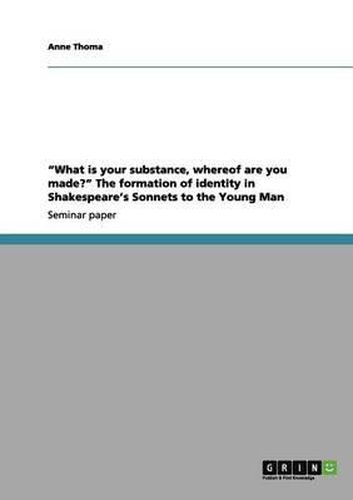Readings Newsletter
Become a Readings Member to make your shopping experience even easier.
Sign in or sign up for free!
You’re not far away from qualifying for FREE standard shipping within Australia
You’ve qualified for FREE standard shipping within Australia
The cart is loading…






Seminar paper from the year 2006 in the subject English Language and Literature Studies - Literature, grade: 1,0, University of Tubingen, course: Sonnet Cycles from the 16th to the 20th Centuries, 31 entries in the bibliography, language: English, comment: This text looks at Shakespeare’s Sonnets in the light of an important Renaissance issue: It deals with identity and its various sources, focussing on the relationship of the poet and the young man., abstract: Shakespeare’s sonnets have often been discussed in terms of the degree of their autobiographical content. The question what role the persons which the poet addresses, a young man and a dark woman, had actually played in the author’s life sparked as much debate as the opaque initials W. H., a dedication by Thomas Thorpe, who had published a Quarto by the title of ‘Shakespeare’s Sonnets. Never before imprinted’ in 1609 (Edmondson / Wells 4). Some critics were led to conclude their research with triumphant statements such as ‘Shakespeare’s Sonnets. The Problems solved’, a title employed by A. L. Rowse in 1964. Rowse claims to have spotted the identity of the young man, the dark lady, the rival poet, as well as of W. H.. His edition of the sonnets also includes a chapter called The Story: its Outlines (24). Other critics have been focussing less on a coherent story with identifiable characters. In their analysis, they often take a purely immanent stance and are more concerned with how the poet, the speaking voice of the sonnets, establishes an identity, a private subjectivity and sensibility and in the course of his amorous encounters engages in a struggle to keep them afloat. I want to argue along the lines of those researchers who put the previously rather central issues of homosocial desire and Platonic and Petrarchan love into the lager context of what Stephen Greenblatt calls the self-fashioning of the Renaissance individual (1). He points out that the power to impose a shape upon oneself or anot
$9.00 standard shipping within Australia
FREE standard shipping within Australia for orders over $100.00
Express & International shipping calculated at checkout
Seminar paper from the year 2006 in the subject English Language and Literature Studies - Literature, grade: 1,0, University of Tubingen, course: Sonnet Cycles from the 16th to the 20th Centuries, 31 entries in the bibliography, language: English, comment: This text looks at Shakespeare’s Sonnets in the light of an important Renaissance issue: It deals with identity and its various sources, focussing on the relationship of the poet and the young man., abstract: Shakespeare’s sonnets have often been discussed in terms of the degree of their autobiographical content. The question what role the persons which the poet addresses, a young man and a dark woman, had actually played in the author’s life sparked as much debate as the opaque initials W. H., a dedication by Thomas Thorpe, who had published a Quarto by the title of ‘Shakespeare’s Sonnets. Never before imprinted’ in 1609 (Edmondson / Wells 4). Some critics were led to conclude their research with triumphant statements such as ‘Shakespeare’s Sonnets. The Problems solved’, a title employed by A. L. Rowse in 1964. Rowse claims to have spotted the identity of the young man, the dark lady, the rival poet, as well as of W. H.. His edition of the sonnets also includes a chapter called The Story: its Outlines (24). Other critics have been focussing less on a coherent story with identifiable characters. In their analysis, they often take a purely immanent stance and are more concerned with how the poet, the speaking voice of the sonnets, establishes an identity, a private subjectivity and sensibility and in the course of his amorous encounters engages in a struggle to keep them afloat. I want to argue along the lines of those researchers who put the previously rather central issues of homosocial desire and Platonic and Petrarchan love into the lager context of what Stephen Greenblatt calls the self-fashioning of the Renaissance individual (1). He points out that the power to impose a shape upon oneself or anot